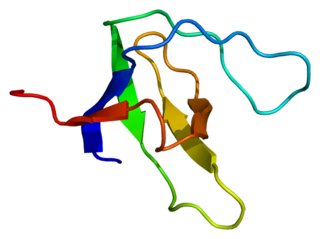
Nephronophthisis is a genetic disorder of the kidneys which affects children. It is classified as a medullary cystic kidney disease. The disorder is inherited in an autosomal recessive fashion and, although rare, is the most common genetic cause of childhood kidney failure. It is a form of ciliopathy. Its incidence has been estimated to be 0.9 cases per million people in the United States, and 1 in 50,000 births in Canada.

Podocin is a protein that in humans is encoded by the NPHS2 gene.

Nephrocystin-1 is a protein that in humans is encoded by the NPHP1 gene.

The Abelson helper integration site 1 (AHI1) is a protein coding gene that is known for the critical role it plays in brain development. Proper cerebellar and cortical development in the human brain depends heavily on AHI1. The AHI1 gene is prominently expressed in the embryonic hindbrain and forebrain. AHI1 specifically encodes the Jouberin protein and mutations in the expression of the gene is known to cause specific forms of Joubert syndrome. Joubert syndrome is autosomal recessive and is characterized by the brain malformations and mental retardation that AHI1 mutations have the potential to induce. AHI1 has also been associated with schizophrenia and autism due to the role it plays in brain development. An AHI1 heterozygous knockout mouse model was studied by Bernard Lerer and his group at Hadassah Medical Center in Jerusalem to elucidate the correlation between alterations in AHI1 expression and the pathogenesis of neuropsychiatric disorders. The core temperatures and corticosterone secretions of the heterozygous knockout mice after exposure to environmental and visceral stress exhibited extreme repression of autonomic nervous system and hypothalamic-pituitary-adrenal responses. The knockout mice demonstrated an increased resilience to different types of stress and these results lead to a correlation between emotional regulation and neuropsychiatric disorders.

Centrosomal protein of 290 kDa is a protein that in humans is encoded by the CEP290 gene. CEP290 is located on the Q arm of chromosome 12.

Inversin is a protein that in humans is encoded by the INVS gene.

Dyslexia susceptibility 1 candidate gene 1 protein is a protein that in humans is encoded by the DYX1C1 gene. This protein contains 420-amino acids with 3 tetratricopeptide repeat (TPR) domains, thought to mediate protein–protein interactions.

Nephrocystin-4 is a protein that in humans is encoded by the NPHP4 gene.

MAL-like protein is a protein that in humans is encoded by the MALL gene.

IQ calmodulin-binding motif-containing protein 1 is a protein that in humans is encoded by the IQCB1 gene.

Nephrocystin-3 is a protein that in humans is encoded by the NPHP3 gene.

Tetratricopeptide repeat protein 3 is a protein that in humans is encoded by the TTC3 gene.

Serologically defined colon cancer antigen 8 is a protein that in humans is encoded by the SDCCAG8 gene. This protein localizes to the centrioles.

Tetratricopeptide repeat protein 4 is a protein that in humans is encoded by the TTC4 gene.

Meckelin is a protein that in humans is encoded by the TMEM67 gene.

Tetratricopeptide repeat domain 8 (TTC8) also known as Bardet–Biedl syndrome 8 is a protein that in humans is encoded by the TTC8 gene.

Leucine-rich repeat-containing protein 50 is a protein that in humans is encoded by the LRRC50 gene.
Xaa-Pro aminopeptidase 3, also known as aminopeptidase P3, is an enzyme that in humans is encoded by the XPNPEP3 gene. XPNPEP3 localizes to mitochondria in renal cells and to kidney tubules in a cell type-specific pattern. Mutations in XPNPEP3 gene have been identified as a cause of a nephronophthisis-like disease.

Serine/threonine-protein kinase Nek8, also known as never in mitosis A-related kinase 8, is an enzyme that in humans is encoded by the NEK8 gene.

Tetratricopeptide repeat domain 7A (TTC7A) is a protein that in humans is encoded by the TTC7A gene.

















